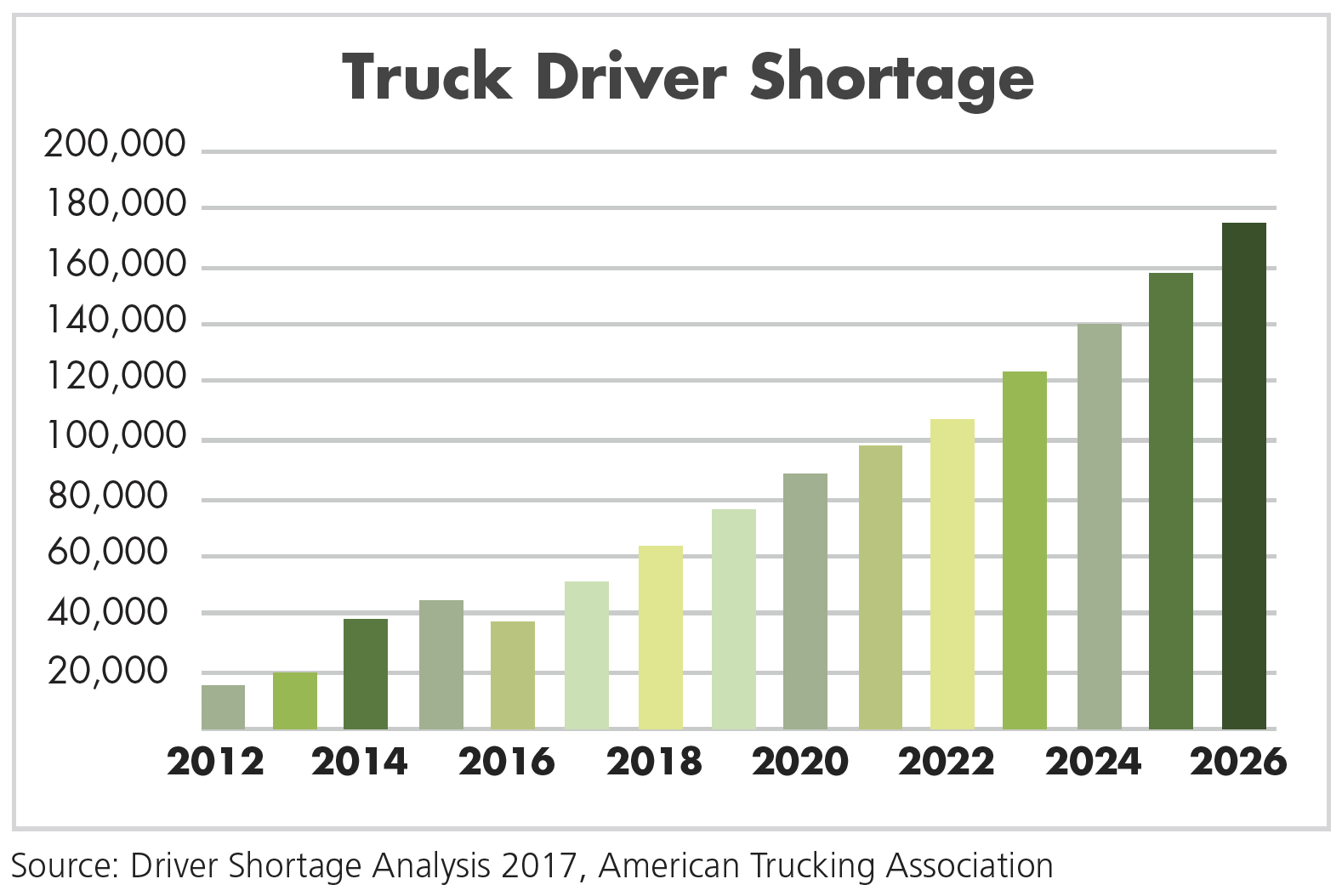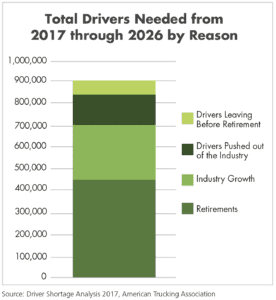

Aug 15, 2018Keep on Trucking: Growers aim to navigate driver shortage, new regulations
A nationwide shortage of truck drivers and shifting federal rules add obstacles to the task of shipping fresh plants and product.
Difficulty hiring and retaining drivers, federally-mandated electronic logging devices and hours of service in the trucking industry are likely to increase shipping costs and affect availability.
“Price increases and availability,” said Talmadge Coley, director of government affairs for AmericanHort, a horticulture industry group. “Those two things seem to be what I hear about the most from our members and our industry across the country.
“For the horticulture industry, this is our high season so we’re bearing the brunt, much like the produce industry in the beginning of the year,” he said. “So, it’s our turn to deal with these things. It’s a tough pill to swallow.”

Driver shortage
The shortage of truck drivers in America is not a new issue, but along with fuel prices and increased federal oversight, it greatly increases the difficulty of shipping freight.
In a 2017 analysis, the American Trucking Association (ATA) estimated the industry would be short 50,000 drivers by the end of the year, with the figure reaching more than 63,000 in 2018. At this rate, the shortage could pass 174,000 drivers by 2026.
“If the trend stays on course, there will likely be severe supply chain disruptions resulting in significant shipping delays, higher inventory carrying costs, and perhaps shortages at stores,” according to the ATA’s analysis. While the association isn’t saying the shortage will actually reach that level, “instead, this is more of a warning to the industry and the broader supply chain of what could happen if things don’t change.”
ATA has suggested a number of courses of action for the industry, including driver pay increases, more at-home time, a lower driver age, improved driver image and even “better treatment by the supply chain.” Driver complaints range from restricted access to restrooms to long waits for the trailer to be loaded or unloaded.
“Improving the experience for drivers at drop-off and pickup locations would provide for a more attractive career choice,” according to the ATA’s analysis.

Electronic logging devices
The federal rule requiring commercial truckers to use electronic logging devices is reforming the way America ships freight. However, a statutory exemption for “agricultural operations,” plus a series of waivers and delays have prevented the rule so far from taking full effect.
The devices make it easier for feds to enforce rules limiting number of hours drivers work, known as “hours of service,” and specifically the number of hours they drive, during a shift, or total over a week.
“Since 1938, complex, on-duty/ off-duty logs for truck and bus drivers were made with pencil and paper, virtually impossible to verify,” U.S. Transportation Secretary Anthony Foxx said in 2015 when the electronic logging device (ELD) rule was published.
But while proponents of the ELD will say the devices prevent drivers from “fudging” the numbers, opponents like Coley say it doesn’t leave any “wiggle room” for unexpected delays.
“We’ve actually been a proponent of some flexibility with these hours of service rules,” he said.
The statutory exemption for agricultural operations applies to shippers who only operate within a 150-mile radius or who do not cross state lines.
At press time in May, the U.S. Department of Transportation had yet to issue guidance on what exactly constitute agricultural operations.
“The definition, and who it applies to, is very vague,” Coley said. “There’s not a lot of paint on the canvas, so to speak, as to who’s included and who isn’t. We have met with FMCSA (Federal Motor Carrier Safety Administration) enforcement officials here in D.C. and they have seemed to have a very narrow definition as to who is included in this definition, whereas when you read how it’s written into the law, it’s very broad.”
After the ELD rule was published in December 2015, transport companies were first given two years to prepare for compliance, and enforcement of the rule was extended by an additional 90 days, to April 1, 2018, said Duane DeBruyne, deputy director, Office of Communications/Media Relations for FMCSA. In March, FMCSA granted a limited waiver for transporters of agricultural commodities, pushing compliance for ELDs out until July 18, 2018. A spending bill signed by the president has pushed the DOT’s enforcement of the ELD rule out even further, to Sept. 31, but only for transporters of livestock and insects like honeybees (formal comments on the rules have included concerns about the animals and bugs dying during federally-mandated delays in transit).
“The March 23, 2018 waiver does not change federal hours of service (HOS) regulations, does not change HOS roadside enforcement, (and) does not change existing HOS exemptions,” DeBruyne said.
DeBruyne defended the ELD rule, which he said is estimated to save more than 25 lives and prevent more than 500 injuries a year from crashes involving commercial trucks and buses.
“The ELD rule will result in an annual net benefit of more than $1 billion – largely by reducing the amount of required industry paperwork,” he said.
Cost/benefit analysis
How much the ELD rule benefits a specialty crop grower depends on what the grower is producing and what markets he or she is selling it in.
“Some states are hit a little bit worse than others,” Coley said.
Growers in western states are shipping hundreds upon hundreds of miles to reach their markets and have already seen the price of shipping increase. On the other hand, increased regulations and their associated costs could actually work in favor of growers shipping to regional markets.
For instance, at a March gathering of asparagus growers in Michigan, Ken Wall, owner of Sandy Shore Farms, in Ontario, Canada, said he thought the ELD rule could actually give local growers an advantage in regional markets over growers from Mexico and possibly the American Southwest.
“You can’t have a second set of books anymore,” he said. “Why does that matter? Product coming from Mexicali … coming on up into Chicago, coming into Detroit, coming into the East Coast terminal markets – that is going to take a little more time to actually get into those marketplaces. Another day or two on Mexican product to get into some of our markets that we have been utilizing and taking advantage of over the years – that’s older product. That’s more costly product to get there.
“Most of us are shipping product within a 12- or 13-hour range, and we don’t have to deal with some of those concerns,” Wall said. “The price of trucking is going to be up this year, I don’t doubt that for a second. But we are going to be less impacted than Mexico and some of Peruvian imports are going to be.”
– Stephen Kloosterman, VGN Associate Editor














